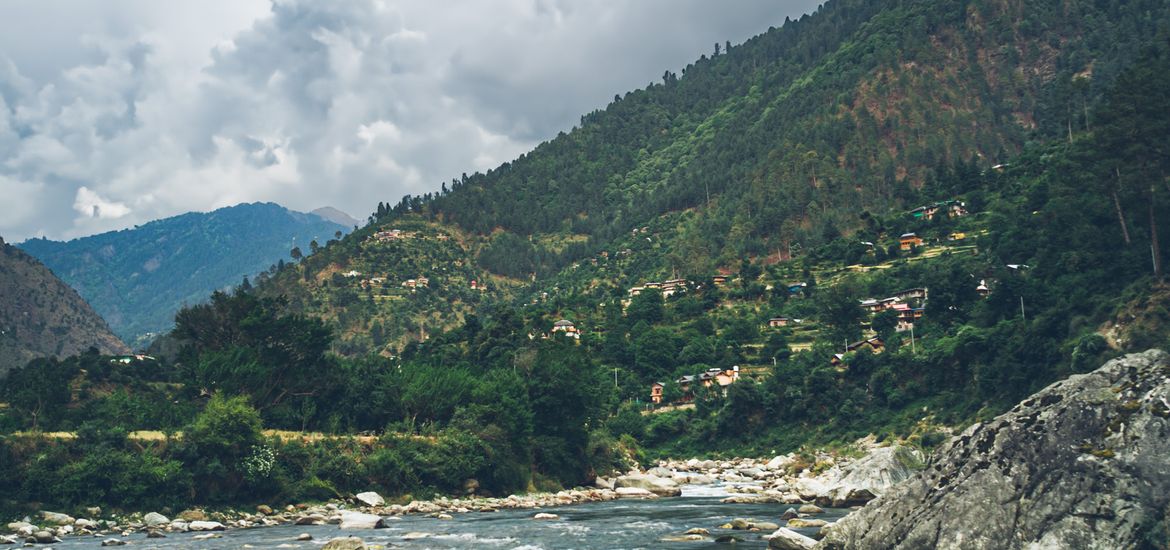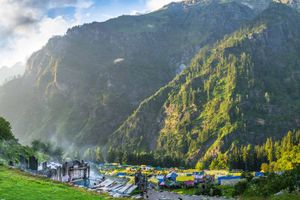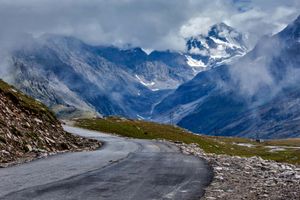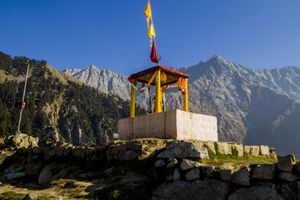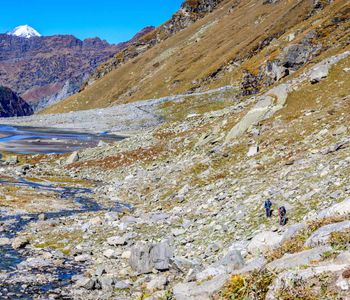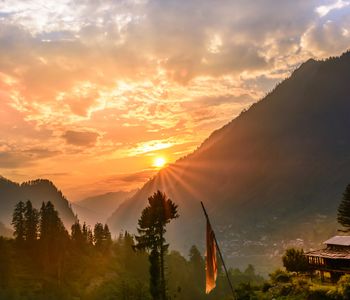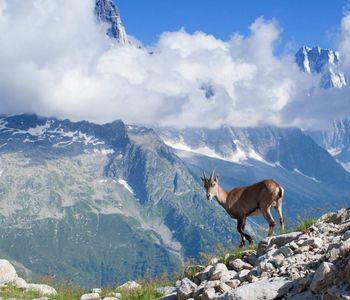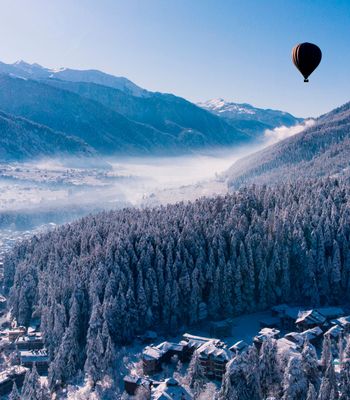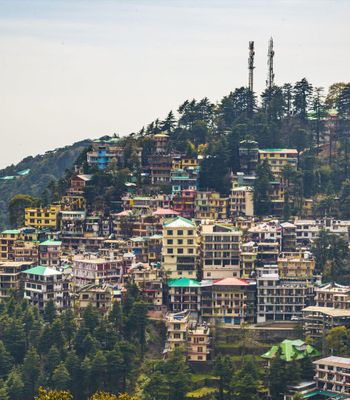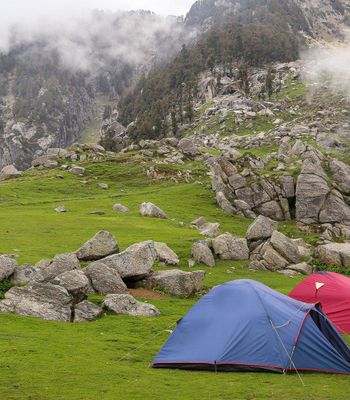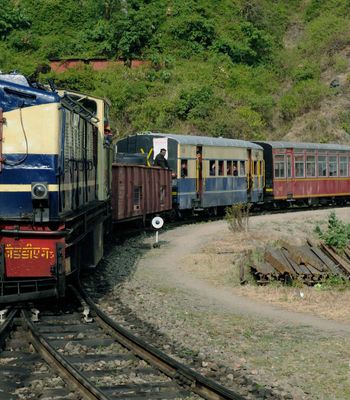Tirthan Valley, tucked in the folds of Kullu district, is like a page from a forgotten folktale that leaves an unforgettable mark on your heart. The surroundings of the valley are filled with misty hills, pine forests, quaint wooden homes, and a pristine river that defines the region. Having stayed out of the grasp of over-tourism, so when you visit, you can truly feel, introspect between the meadows, and embark on bold adventures in trout-laden waters.
Where Myth and Memory Flow Together
The name ‘Tirthan Valley’ comes from the Tirthan River, a tributary of the Beas River that originates from a sacred spring near the Hanskund Peak, called Tirth. This has also led the locals and visitors to consider the river’s banks as holy ground.
When you turn the pages of the history of the valley, you’ll find a community that lives in harmony with nature that relies on agriculture, animal husbandry, and traditional crafts. Much of this way of life still exists in Tirthan Valley as they, preserved over time due to the valley’s isolated location.
Built to Endure: The Timeless Art of Kath Kuni Architecture
The Kath Kuni architecture originated in Himachal Pradesh. The villages of Tirthan Valley stayed true to their traditional architecture, and the houses here are proof of that. This construction technique, which involves alternating layers of wood and stone, is perfect for Himalayan winters as these materials provide durability and insulation.
Nature's Secrets: Sights You Can’t Miss in Tirthan
Tirthan Valley has sights for every type of traveller from an adrenaline junkie, a seeker of peace to a fan of wildlife. Here are some places you shouldn’t miss if you’re either of them:
Great Himalayan National Park (GHNP)
GHNP is a UNESCO World Heritage Site and a treasure trove for a lover of the wild. They serve as a home for over 1000 plant species, 31 mammal species, and 209 bird species. They protect various endangered mammals, such as the snow leopard, musk deer, and western tragopan. It also offers different trails like the Rolla trek, the Rangthar trek, and the Ookhal thach trek, ranging from an easy walk to a challenging expedition, or anything in between.
Jalori Pass
Jalori Pass is situated at an altitude of 3,120 meters in the Tirthan Valley. It is a starting point for multiple treks, including the Raghupur fort trek, the Lambri trek, and the Sakiran trek. Since it’s at a high altitude, it offers travellers panoramic views of the nearby peaks and valleys. Additionally, it’s accessible by road during the summer months.
Serolsar Lake
Serolsar Lake, located 6 km away from the Jalori Pass, is for the nature lover in you. It boasts of crystal clear waters, snowcapped peaks, and dense forests. While the trek to this place is moderately difficult, it’s worth the effort since it has crystal-clear water and is surrounded by dense forest.
Chhoie Waterfall
The short trek from Gushaini village to Chhoie waterfall is a journey filled with lush greenery and glimpses of the valley’s birdlife. The name Chhoie is derived from the local deity of the same name.
Trout Fishing
The Tirthan River has a notorious trout population. This has led to anglers from across the country visiting the valley to try their luck catching the fish. Remember that you must have a fishing permit, and if you don’t have one, you can obtain it locally as well.
When the Valley Whispers: Best Seasons of Tirthan
The best time to visit any valleys is when the weather is pleasant and the vegetation of the region is in full bloom. You can find Tirthan Valley in this prime condition between March and June, and the autumn months of October and November. During this window, you can take in the vibrant landscapes, trek, go fishing, and even spot wildlife.
Getting There: Following the River to Solitude
Here’s how you can reach this accessible Himalayan sanctuary:
By Air
Bhuntar Airport, which is 50 kilometres from Tirthan Valley, is the closest airport to reach Tirthan Valley. From the airport, you can pick a service of your choice between taxis and buses to cover the rest of the distance.
By Train
Joginder Nagar and Chandigarh are the closest railway stations to Tirthan Valley, being 122 km and 250 km away, respectively. To cover the rest of the distance to the valley, taxis and buses are available outside the railway stations.
By Road
Tirthan Valley is connected to major cities such as Delhi, Chandigarh, and Shimla via roads. Buses and taxis regularly make trips back and forth to and from the Tirthan Valley to these cities if you prefer a journey with the scenic views of the Himalayan landscape.
Valley of Rituals: Where Seasons Turn into Seasons
The months of February or March often mark the end of winter and the beginning of the harvest season in many parts of India. This window is celebrated as the Fagli Festival by the locals of Tirthan Valley. This celebration begins by cleaning the houses and lighting oil lamps, symbolising the banishment of evil.
The most captivating and unmissable part of this celebration is the men dressed as deities and spirits. They go all in with the grass skirts, woollen robes, and even wear elaborate wood masks. Since the celebration is for the commencement of the harvest season, these figures also perform traditional dances in village squares to invoke the blessings for fertile crops. So, if you’re visiting during this celebration, don’t miss this spiritual theatre of the mountains!
Tirthan Valley is more than just a destination to visit; it’s an experience that’ll rejuvenate your soul and help you meet yourself. From trekking and fishing to simply soaking in the serene landscapes, the valley offers a package of adventure and tranquillity. In a world where deadlines and hustle have taken over our lives, Tirthan Valley asks you to slow down. To be in the moment, surrounded by nature and silence that feels like a hug.
